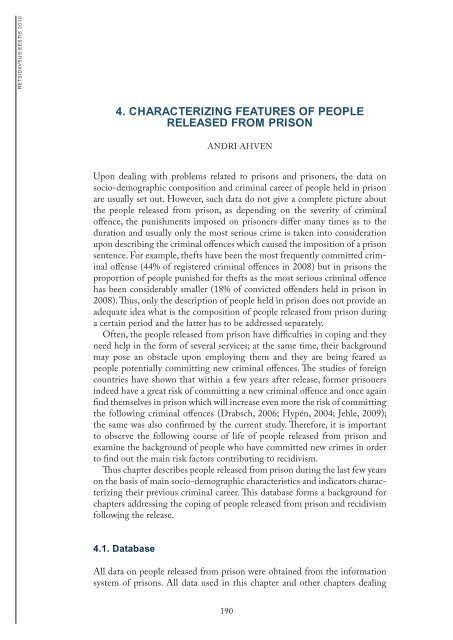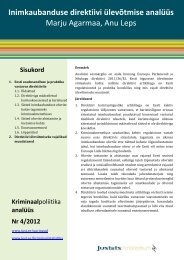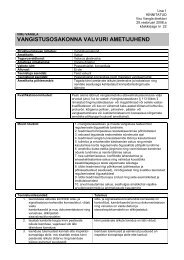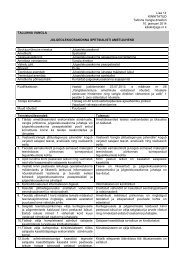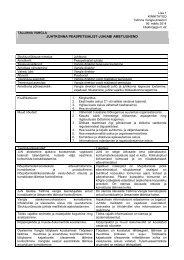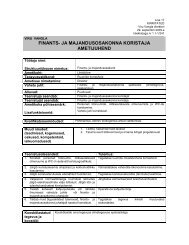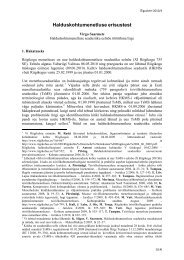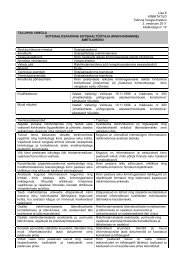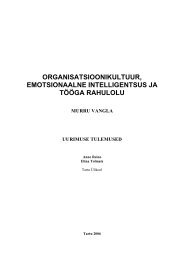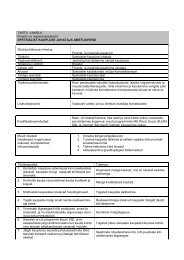11. Retsidiivsus Eestis - Justiitsministeerium
11. Retsidiivsus Eestis - Justiitsministeerium
11. Retsidiivsus Eestis - Justiitsministeerium
You also want an ePaper? Increase the reach of your titles
YUMPU automatically turns print PDFs into web optimized ePapers that Google loves.
RETSIDIIVSUS EESTIS 2010<br />
4. CHARACTERIZING FEATURES OF PEOPLE RELEASED FROM PRISON<br />
RETSIDIIVSUS EESTIS 2010<br />
4. CHARACTERIZING FEATURES OF PEOPLE<br />
RELEASED FROM PRISON<br />
ANDRI AHVEN<br />
Upon dealing with problems related to prisons and prisoners, the data on<br />
socio-demographic composition and criminal career of people held in prison<br />
are usually set out. However, such data do not give a complete picture about<br />
the people released from prison, as depending on the severity of criminal<br />
offence, the punishments imposed on prisoners differ many times as to the<br />
duration and usually only the most serious crime is taken into consideration<br />
upon describing the criminal offences which caused the imposition of a prison<br />
sentence. For example, thefts have been the most frequently committed criminal<br />
offense (44% of registered criminal offences in 2008) but in prisons the<br />
proportion of people punished for thefts as the most serious criminal offence<br />
has been considerably smaller (18% of convicted offenders held in prison in<br />
2008). Thus, only the description of people held in prison does not provide an<br />
adequate idea what is the composition of people released from prison during<br />
a certain period and the latter has to be addressed separately.<br />
Often, the people released from prison have difficulties in coping and they<br />
need help in the form of several services; at the same time, their background<br />
may pose an obstacle upon employing them and they are being feared as<br />
people potentially committing new criminal offences. The studies of foreign<br />
countries have shown that within a few years after release, former prisoners<br />
indeed have a great risk of committing a new criminal offence and once again<br />
find themselves in prison which will increase even more the risk of committing<br />
the following criminal offences (Drabsch, 2006; Hypén, 2004; Jehle, 2009);<br />
the same was also confirmed by the current study. Therefore, it is important<br />
to observe the following course of life of people released from prison and<br />
examine the background of people who have committed new crimes in order<br />
to find out the main risk factors contributing to recidivism.<br />
Thus chapter describes people released from prison during the last few years<br />
on the basis of main socio-demographic characteristics and indicators characterizing<br />
their previous criminal career. This database forms a background for<br />
chapters addressing the coping of people released from prison and recidivism<br />
following the release.<br />
4.1. Database<br />
All data on people released from prison were obtained from the information<br />
system of prisons. All data used in this chapter and other chapters dealing<br />
with people released from prison cover people convicted by court who were<br />
released from prison in 2004-2007 due to one of the following reasons:<br />
• The sentence has been fully served;<br />
• The prison sentence imposed to be served in part has been fully served;<br />
• Release on parole;<br />
• Electronic surveillance is imposed upon release on parole (possible since<br />
2007);<br />
• Pardon.<br />
If some of these people had been repeatedly released from prison under the<br />
bases referred herein because of repeatedly being in held in prison during the<br />
same year, the last of these releases was chosen (being held in prison as an<br />
arrested person was not counted).<br />
All arrested people were left out from observation. A small number of<br />
convicted offenders, who were released due to an incurable disease or sent to<br />
another country to serve their sentence, as well as people who died in prison<br />
and people with a missing, defective or non-standard (e.g. foreign country)<br />
personal identification code55, who from the aspect of recidivism are not of<br />
interest and were therefore left out from the analysis.<br />
One and the same person could have committed criminal offences of<br />
different type and sentenced to prison and released from prison several times<br />
during the observation period. The analysis takes into consideration all criminal<br />
offences which caused the imposition of imprisonment, not just the most<br />
serious one. Thus, one and same person may occur repeatedly:<br />
• Among people released in different year;<br />
• In case of people released during the same year in the lists of people who<br />
committed several criminal offences of the same type (upon committing<br />
several criminal offence of the same type56 each person is taken into<br />
consideration only once).<br />
In all observed groups (e.g. people released in 2004 who were held in prison<br />
for manslaughter or murder) each person always appears once. Data reflect the<br />
number of people, not the number of criminal offences committed by them –<br />
primarily in case of criminal offences against property prison sentence could<br />
have been imposed for several criminal offences at once; this occurred less<br />
frequently in case of serious crimes of violence.<br />
In case of criminal offences which caused the imposition of prison sentence<br />
the criminal offences registered both on the basis of the Penal Code (PC) and<br />
55 The number of people with missing or non-standard personal identification code among the released people was<br />
37 (1,6%) in 2004, 17 (0,7%), in 2005, 13 (0,5%) in 2006 and in 11 (0,4%) 2007.<br />
56 A type of criminal offence is always considered with the exactness of the Code of Criminal Procedure section<br />
without differentiating individual subsections or clauses.<br />
190<br />
191


